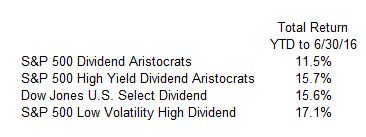This morning’s CPI report for June looked like the last few reports showing inflation at about one percent in the last 12 months. However, beneath the surface things are shifting around and giving hints that a year from now prices could be noticeably higher than they are today. A modest rise in inflation over the next year or so shouldn’t be a surprise. Current economic conditions can support higher prices: the economy is expanding, unemployment is down and consumers are confident and spending money. The current low levels of inflation are due to the strong dollar, falling food prices and formerly falling energy prices.
The “core CPI,” the index excluding the volatile food and energy segments, is a good way to understand inflation. The first chart shows 20 years of the total CPI in red and the core CPI in blue, both series measured as the percentage change over the previous 12 months. The overall CPI in red gyrates up and down, largely driven by the surges and collapses in oil prices in recent years while the blue line reveals more gentle movements. In recent months both are rising.

In the year ended in June 2016, the overall CPI rose 2.3%; the food component was up 0.3% and the energy component was down 9.4%. Today falling energy prices are keeping inflation down. However, falling energy and oil prices may be a thing of the past. Oil rebounded from its lows. Even if oil and energy prices stay where they are, overall inflation will rise. The second chart shows the overall CPI (blue bars) and WTI oil (red line). As seen there, after oil prices peaked in 2014, inflation reversed and began to climb in 2015. When oil rose earlier this year, inflation rose along with it.

No one expects a rapid return to double digit inflation. However, the days when everyone assumed inflation would be zero forever maybe ending. In a growing economy when businesses and consumers are less resistant to attempts to raise prices, higher prices eventually stick.
The posts on this blog are opinions, not advice. Please read our Disclaimers.








